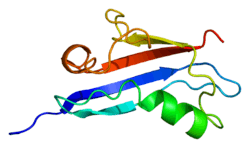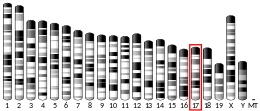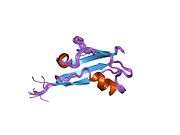RGL2
Ral guanine nucleotide dissociation stimulator-like 2 is a protein that in humans is encoded by the RGL2 gene.[5][6]
Interactions
RGL2 has been shown to interact with HRAS.[7][8]
gollark: * hijäcked
gollark: NSA recordings would also be acceptable.
gollark: Sorry, my internet connection became temporarily an infinitely large swarm of bees.
gollark: They know that *they* are secretly a sentient TF2 mod.
gollark: It is. All other games are TF2 mods or fake.
References
- ENSG00000237441, ENSG00000237825, ENSG00000224841, ENSG00000206282 GRCh38: Ensembl release 89: ENSG00000228736, ENSG00000237441, ENSG00000237825, ENSG00000224841, ENSG00000206282 - Ensembl, May 2017
- GRCm38: Ensembl release 89: ENSMUSG00000041354 - Ensembl, May 2017
- "Human PubMed Reference:". National Center for Biotechnology Information, U.S. National Library of Medicine.
- "Mouse PubMed Reference:". National Center for Biotechnology Information, U.S. National Library of Medicine.
- Isomura M, Okui K, Fujiwara T, Shin S, Nakamura Y (January 1997). "Isolation and mapping of RAB2L, a human cDNA that encodes a protein homologous to RalGDS". Cytogenet Cell Genet. 74 (4): 263–5. doi:10.1159/000134431. PMID 8976381.
- "Entrez Gene: RGL2 ral guanine nucleotide dissociation stimulator-like 2".
- Mitin NY, Ramocki MB, Zullo AJ, Der CJ, Konieczny SF, Taparowsky EJ (May 2004). "Identification and characterization of rain, a novel Ras-interacting protein with a unique subcellular localization". J. Biol. Chem. 279 (21): 22353–61. doi:10.1074/jbc.M312867200. PMID 15031288.
- Peterson SN, Trabalzini L, Brtva TR, Fischer T, Altschuler DL, Martelli P, Lapetina EG, Der CJ, White GC (November 1996). "Identification of a novel RalGDS-related protein as a candidate effector for Ras and Rap1". J. Biol. Chem. 271 (47): 29903–8. doi:10.1074/jbc.271.47.29903. PMID 8939933.
Further reading
- Peterson SN, Trabalzini L, Brtva TR, Fischer T, Altschuler DL, Martelli P, Lapetina EG, Der CJ, White GC (1997). "Identification of a novel RalGDS-related protein as a candidate effector for Ras and Rap1". J. Biol. Chem. 271 (47): 29903–8. doi:10.1074/jbc.271.47.29903. PMID 8939933.
- Herberg JA, Sgouros J, Jones T, Copeman J, Humphray SJ, Sheer D, Cresswell P, Beck S, Trowsdale J (1998). "Genomic analysis of the Tapasin gene, located close to the TAP loci in the MHC". Eur. J. Immunol. 28 (2): 459–67. doi:10.1002/(SICI)1521-4141(199802)28:02<459::AID-IMMU459>3.0.CO;2-Z. PMID 9521053.
- Herberg JA, Beck S, Trowsdale J (1998). "TAPASIN, DAXX, RGL2, HKE2 and four new genes (BING 1, 3 to 5) form a dense cluster at the centromeric end of the MHC". J. Mol. Biol. 277 (4): 839–57. doi:10.1006/jmbi.1998.1637. PMID 9545376.
- Ando A, Kikuti YY, Abe K, Shigenari A, Kawata H, Ikemura T, Kimura M, Inoko H (1999). "cDNA cloning, northern hybridization, and mapping analysis of a putative GDS-related protein gene at the centromeric ends of the human and mouse MHC regions". Immunogenetics. 49 (4): 354–6. doi:10.1007/s002510050504. PMID 10079301.
- Wiemann S, Weil B, Wellenreuther R, Gassenhuber J, Glassl S, Ansorge W, Böcher M, Blöcker H, Bauersachs S, Blum H, Lauber J, Düsterhöft A, Beyer A, Köhrer K, Strack N, Mewes HW, Ottenwälder B, Obermaier B, Tampe J, Heubner D, Wambutt R, Korn B, Klein M, Poustka A (2001). "Toward a catalog of human genes and proteins: sequencing and analysis of 500 novel complete protein coding human cDNAs". Genome Res. 11 (3): 422–35. doi:10.1101/gr.GR1547R. PMC 311072. PMID 11230166.
- Mitin NY, Ramocki MB, Zullo AJ, Der CJ, Konieczny SF, Taparowsky EJ (2004). "Identification and characterization of rain, a novel Ras-interacting protein with a unique subcellular localization". J. Biol. Chem. 279 (21): 22353–61. doi:10.1074/jbc.M312867200. PMID 15031288.
- Stelzl U, Worm U, Lalowski M, Haenig C, Brembeck FH, Goehler H, Stroedicke M, Zenkner M, Schoenherr A, Koeppen S, Timm J, Mintzlaff S, Abraham C, Bock N, Kietzmann S, Goedde A, Toksöz E, Droege A, Krobitsch S, Korn B, Birchmeier W, Lehrach H, Wanker EE (2005). "A human protein-protein interaction network: a resource for annotating the proteome". Cell. 122 (6): 957–68. doi:10.1016/j.cell.2005.08.029. hdl:11858/00-001M-0000-0010-8592-0. PMID 16169070.
- Rual JF, Venkatesan K, Hao T, Hirozane-Kishikawa T, Dricot A, Li N, Berriz GF, Gibbons FD, Dreze M, Ayivi-Guedehoussou N, Klitgord N, Simon C, Boxem M, Milstein S, Rosenberg J, Goldberg DS, Zhang LV, Wong SL, Franklin G, Li S, Albala JS, Lim J, Fraughton C, Llamosas E, Cevik S, Bex C, Lamesch P, Sikorski RS, Vandenhaute J, Zoghbi HY, Smolyar A, Bosak S, Sequerra R, Doucette-Stamm L, Cusick ME, Hill DE, Roth FP, Vidal M (2005). "Towards a proteome-scale map of the human protein-protein interaction network". Nature. 437 (7062): 1173–8. doi:10.1038/nature04209. PMID 16189514.
This article is issued from Wikipedia. The text is licensed under Creative Commons - Attribution - Sharealike. Additional terms may apply for the media files.






